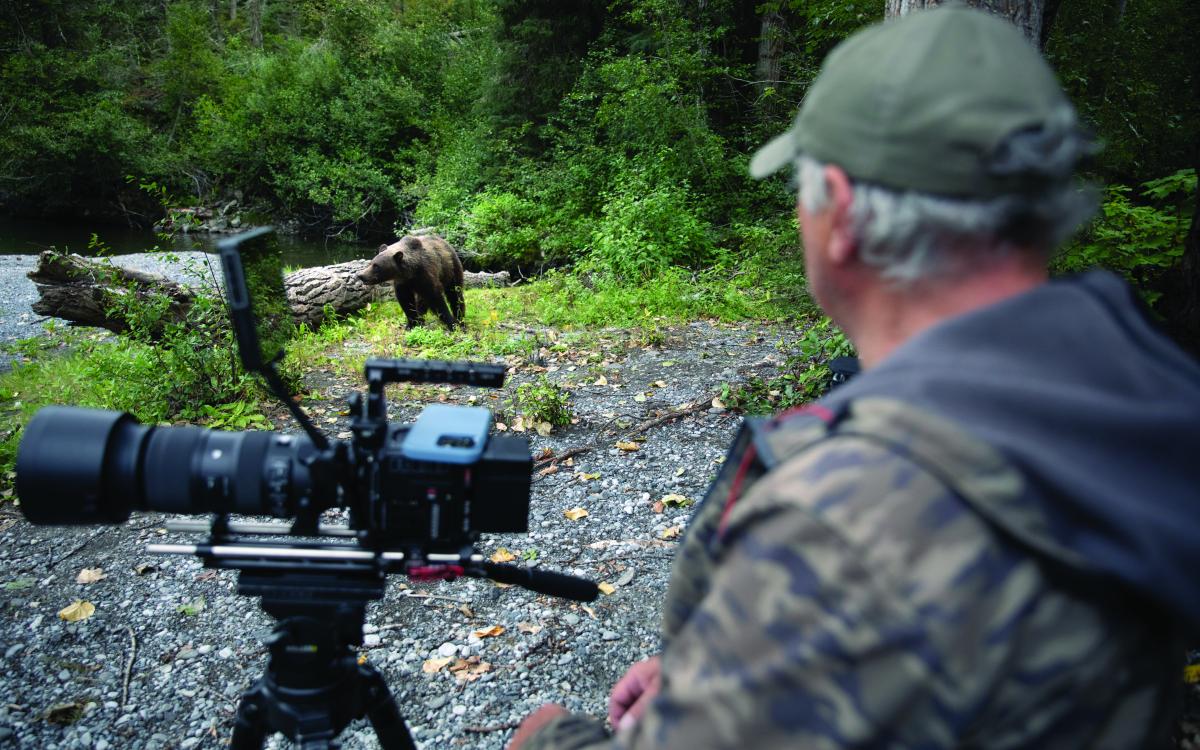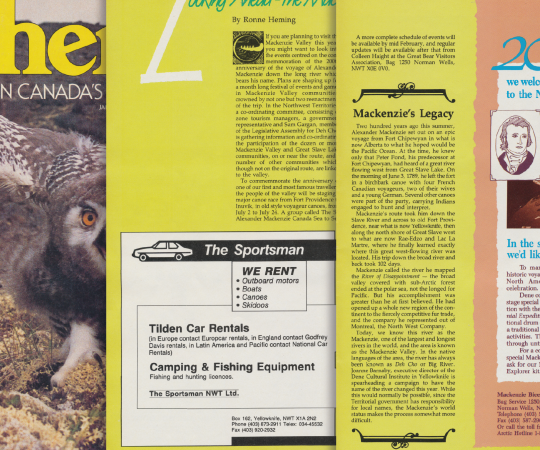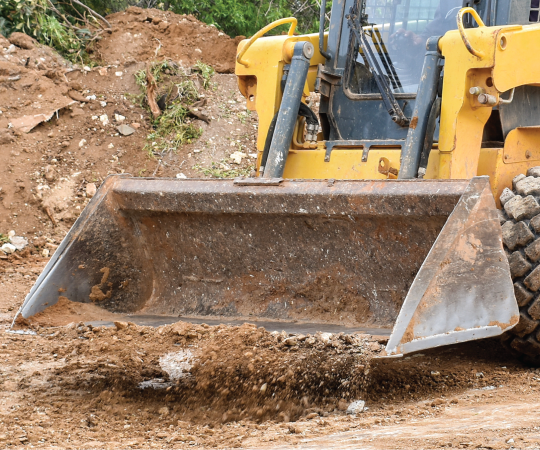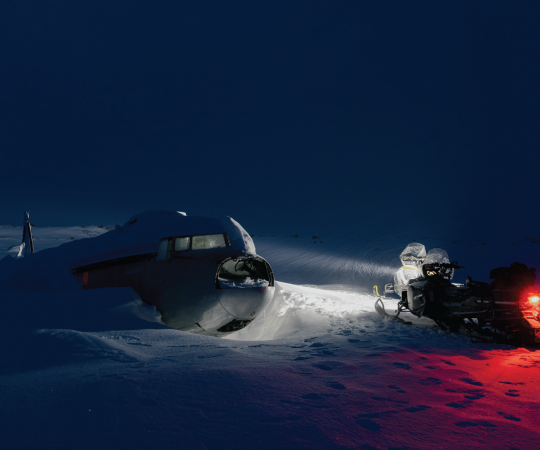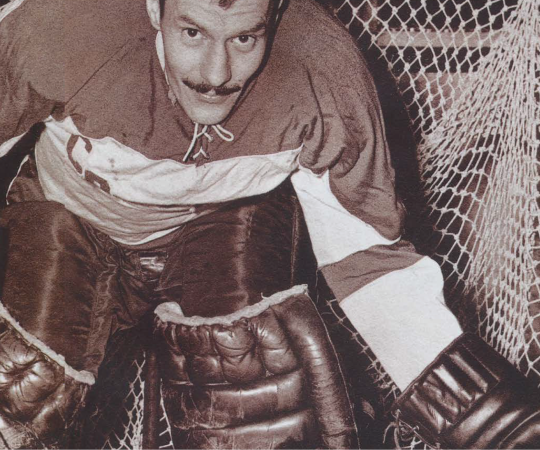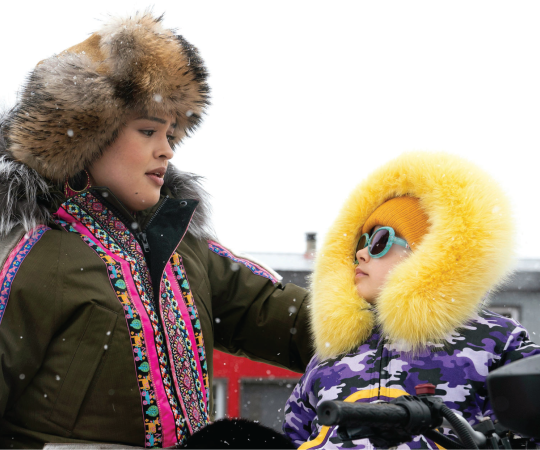The most anxious moment of the day occurred a few hours earlier. Phil Timpany had taken a pair of guests to a gravel bar on the Nakina River where hundreds of spawnedout chinook salmon lay in the water, either dead or dying. They were a feast for the three or so dozen grizzly bears, more in some years, that gather along the river every August to meet the run. One had sauntered past only a few minutes earlier, ignoring the people who’d come to see them. But now there was a heavy-footed crunching in the bushes behind Timpany and his guests. Then, a bear pushed through the foliage, startled it did not have the unhindered access to the river it was expecting.
“Say nothing. And don’t look away,” Timpany whispered, wrapping the fingers of one hand around the barrel of a shotgun at his side and putting his other hand on a can of bear spray strapped to his belt. The heavy gear wouldn’t be necessary, though. It never was. Over decades in the bush along the Nakina as a fisheries research technician, wilderness guide, filmmaker, and traveller, Timpany has come to know and understand its bears—their needs, their behaviours, their desires, and the silent communication of their body language. He may know them almost as well as they know themselves.
And so, with small gestures, eye contact, adjustments in his posture, and a carefully modulated voice, Timpany signalled to the animal, an injured subadult he did not recognize, that it was not in danger, but any attempt at aggression would fail. The bear cautiously tested the boundaries. It stepped forward. It waved its head and grunted quietly. Then, message received, it decided to give Timpany his distance and walked off along the riverbank, stopping briefly to paw at the stones, as if signalling a touch of adolescent defiance.
Moments like these have made Timpany’s reputation as a grizzly bear expert and conservation advocate. He’s neither famous nor is his name attached to major protests or significant court decisions. His impact is more personal: the quiet influence of his documentaries, the relationships he builds within communities, and the one-by-one interactions he has with the few dozen travellers who come to his camp each August. But among those who follow wildlife conservation in the Yukon and northern British Columbia—researchers, policy-makers, and wilderness travellers—Timpany stands out, in the words of one observer, as the “Jane Goodall of grizzly bears.”
That’s not an exaggeration. Unpolished and convivial, Timpany doesn’t share Goodall’s refined and elegant presence. But they are equals in their passion for the animals they seek to understand, their clear-eyed, unromantic view of how the natural world works, their knowledge of how to live in concert with that world, and, most important, what it will take to protect it.
In Timpany’s view, protecting grizzly bears boils down to one word: citizenship. The bears, like all wildlife, have the same right to life that’s granted in the founding documents and legal principles of our own societies. He holds the belief deeply, having gone through a painful personal transformation from hunting guide to conservation advocate, and he is unmoveable in making the case we should explicitly recognize the rights of the bears. “The only way humanity has ever really been successful in saving anything that’s in trouble,” he says, “is by giving it some sort of standing of its own.”
It’s been done with panda bears, he continues, and it’s been done with a lot of avian life. Grizzly bears are another story. “Our relentless search for commerce is destroying grizzly bear habitat, left and right.… What bears will remain in 50 to 100 years will be in small, isolated, probably non-viable groups, in certain places that are protected. They might as well be in captivity.”
That would be almost as big a loss for people as for the animals. We’ve been trained over generations to fear bears, and grizzlies have been hunted to extinction or near-extinction in many parts of the world. But the fear is unfounded, Timpany says. The missing piece is respect for a right to life and the development of ways to integrate that respect into human society. Just as we do with each other as citizens.
In modelling that concept here on the Nakina, he’s come to another conclusion: citizenship works both ways.

BACK AT HIS CAMP'S LODGE, Timpany’s thoughts have moved on from the earlier, briefly anxious bear encounter. There were many other grizzly meetings throughout the day, but none as remarkable (except that it’s completely mind-blowing to be so close to so many bears). Now he’s talking about fish. “They’ve taken huge swaths of salmon out of the Porcupine River,” he says, speaking about a population that’s crashed from 400,000 fish in a strong year to the low tens of thousands. “It just seems like it’s been sacrificed.”
This is an important issue for Timpany. From the early 1990s until a couple of years ago, he ran a grizzly-viewing camp in partnership with the Vuntut Gwitchin at Bear Cave Mountain on Ni’iinlii’njik (Fishing Branch River), a tributary of the Porcupine. A protected area—and the first time a First Nation granted settlement land for use as a park—it used to attract 40 or so grizzlies with an early-winter run of chum salmon.
Already heavy from voracious foraging on fall berries, the bears would feast through the early snows of winter—earning the nickname “ice bears”—before finally retreating to nearby karst caves to den until spring. But they don’t show up anymore thanks to the salmon collapse. They’re fine; the berries are enough for them to build up fat reserves for winter. But without the fish, there’s no reason to delay denning. No bears, no bear viewing.
The loss of business disappoints Timpany, but nowhere near as much as the reckless disruption of an ancient natural cycle, the remarkable evolutionary adaptations that supported it, and the apparent unwillingness to do anything about the loss. “No one has taken responsibility,” he says. “They just blame it on somebody downriver from them or out in the ocean.”
Many factors have contributed to the salmon’s demise, but the major problem is the number of fish taken in commercial and subsistence fisheries, including as food for thousands of sled dogs along the 1,500-kilometre river system. In Timpany’s view, that abuse is the result of failed concepts of wildlife management—ideas he has described as “archaic artifacts of early colonial enterprise”—that have led to devastating losses of habitat for grizzly bears, too. Worldwide, more than 50 per cent has disappeared, including in Western Canada, according to the Committee on the Status of Endangered Wildlife in Canada. In the Lower 48 of the United States, there’s almost nothing left.
Which brings the topic back to citizenship. “The demand for commerce, the demand for security… [we’re] unaccepting of any risk from wildlife, even though you live in bear country,” Timpany says. “We’re just so disconnected with any of the natural world.” And it’s precisely that connection he’s seeking to restore for visitors to his camp on the Nakina, through his films, and through his advocacy for the bears. The goal is simply to show what citizenship for an apex predator, a keystone in any ecosystem, looks like.
That concept comes in to view almost immediately on arrival at the camp, about a 20-minute helicopter flight southeast of Atlin, B.C., along the Coastal Mountain range. After a cheerful welcome, including from Timpany’s dog, Tucker, the first order of business is a review of the rules.
Rule 1: Keep your head up and your eyes open. The Nakina camp’s half-dozen guest cabins nestle in the forest, connected to each other, the outhouse, and the main lodge by paths that wrap around berry bushes. Bears wander through occasionally and will feed at the bushes. Always make sure your path is clear.
Rule 2: Don’t linger outside. Move directly between buildings and leave the paths open for the bears. If you see a bear when leaving a building, head back inside and wait for it to move on. Unless you need to use the toilet (the outhouse has flush toilets), stay in your cabin at night.
Rule 3: Try to keep noise and movement to a minimum. Don’t talk loudly or slam doors.
There are more, and guests themselves aren’t shy about enforcing them. On this day, a veteran of one week at the camp scolded a visitor fresh off the helicopter for walking around the main lodge to its deck facing the river. “We have rules here, you know!” she warned, wagging her finger and reminding the newcomer that people should walk through the lodge rather than around it. Otherwise, they risk surprising a bear out back by appearing suddenly around a corner.
Likewise, when Timpany or a member of his staff leads you to one of the pre-selected viewing spots along the river, they’ll invite you, in whispers, to sit on small stumps to wait for the bears. Tucker, who is alert but surprisingly sanguine in the presence of bears, may be sniffing around close at hand. But if you so much as stand up to, say, take a half dozen steps toward the water’s edge for a closer look at the red-streaked salmon, your guide will promptly order you back to your stump, this time with firm whispers. That’s the point, after all. This is bear country. Let them have it and they’ll be more willing to share.
That philosophy has also driven the design of the Nakina camp. Between the lodge, cabins, outhouse, paths, and viewing spots, it occupies only one-fifth of one per cent of the habitat available to the bears over the kilometre-long stretch of the river on which Timpany operates. The bears move freely, unthreatened by people who they can ignore or easily avoid at their own discretion. “You won’t see any excitement, danger, risk, or aggression from either bear or human,” Timpany says. “You see that the bears are just content to be around here and be around people. They’re fine with it.” The ones that choose not to be around people “still have access to all the habitat.”
In other words, the bears are adapted to the people but, more importantly, the people are adapted to the bears. “Here, we bring people and bears together and let them learn about each other,” Timpany says, articulating a contrast between western culture’s fear of bears and their acceptance in Indigenous societies. The coexistence “was based on two principles. One was that the people knew a lot about the bears. The other one was that the bears knew a lot about the people. That’s what we’ve taken out of the equation.”

AT ITS HEART, Phil Timpany’s story is one of transformation. Born in the Okanagan community of Salmon Arm, he was raised with an irrepressible passion for the outdoors. He would skip school—even hockey, a sport he loved—for the chance to watch deer in the wild. After completing high school, he toyed with the idea of going to university to study biology. He gave up on that plan after meeting a few biologists and deciding they spent too much time behind their desks studying data and not enough in the wilderness they sought to understand.
Eventually, he found himself in the bush doing seasonal work as a guide for trophy hunters seeking grizzly bears. The job left him disgusted, unable to reconcile the idea of killing for sport with his respect for the animals. His recollections are vivid and painful. In one story, he tells of trying to call a former hunting client during a visit to the United States. Instead, he reached the man’s daughter, who told him her father had died. Timpany asked after the trophy the father had taken home and displayed proudly during his life. “She hated it,” he says, “and she threw it in the garbage dump.”
Within the space of two or three seasons, it became clear guiding hunters was anathema to the life in the wilderness Timpany sought to build. Fortunately, he’d also been doing seasonal contract work as a technician on fisheries research with contracts from British Columbia and Alaska. Work as a wildlife researcher became a larger focus and eventually led him to the Nakina. He acquired the licence to open a wilderness camp in the mid-1970s and started bringing in guests.
In his decades living among grizzly bears, Timpany has come to especially appreciate the intelligence, the emotional range, and the individuality of the animals, qualities that are reflected more in First Nation traditional knowledge than the data of the academic world. Gwich’in lore tells of a time when grizzly bears and people were equals and warns that one should never speak poorly of the bears. They can read people’s thoughts and may take out their anger if you encounter one alone in the wild. A Chilkat tale tells of bears who, understanding the experience, befriend a man who lost his family so he wouldn’t be lonely. “I haven’t found one story yet that contains conflict,” Timpany says. “They call them grandfathers. They call them ancestors. They give them human status.… There’s the Tlingit story of the woman who married a bear. There’s some conflict in it, but it was caused by humans and a misunderstanding.”
Don’t mistake Timpany’s view of the natural world and its history as dreamy idealism. It’s not. He speaks science and policy fluently. Business, too. And the values he articulates are based on decades of observation and experience. Small wonder, then, that he arrived at conclusions that reflect the respect for co-existence developed by cultures that have lived with the bears for thousands of years.
The one point where emotion starts to intrude on Timpany’s otherwise plain-spoken style is when he talks about his time as a hunting guide. His candour is honourable, especially when he adds an extra detail: trophy hunters are not reliably good shots when their big moment comes. Put it down to excitement, nerves, stress, or a combination of all three. Many will mortally wound a bear when they shoot, but not kill it. The job of finishing off the poor creature often falls to the guides. One season, Timpany and his assistant had to kill 11 of the 13 bears their clients had shot.
“I was responsible for a lot of grizzly-bear deaths. I feel that I owe them,” he said in a 2020 podcast interview with the Vancouver-based Grizzly Bear Foundation. “I’m trying really hard to pay that debt back. And also, out of respect for the animal for being so intelligent and being so able to understand what co-existence is with me.”

THE DECK of the Nakina camp’s main lodge is an excellent platform for bear watching. The riverbank is more or less at your feet, you can see long distances up and down the waterway as well as across it, and there’s a path between the deck and the river that bears use to access a nearby tree where they scratch their backs.
Timpany is here with Tucker talking about how grizzly bears have stopped coming to Bear Cave Mountain. A radio on his belt crackles; Tucker’s ears perk up slightly. Timpany’s son, Ross, who’s working in another part of the camp, is calling to say a bear downriver has started ambling toward the lodge. “There he is. I can see him,” Timpany radios back. “He’s coming on the bank. There, way down.”
And with that, all conversation stops. Timpany’s focus is entirely on the bear in the distance. You’d think he’d be used to seeing
ring that assessment but doesn’t entirely reject it. After a moment’s thought, he offers a more nuanced take. “I think Phil has always had a struggle with the whole institutional framework of our society, especially back in the late ’60 and early ’70s, when he knew he wanted to work with wildlife.”
Indeed, the conservation movement we know today was nascent in those days. Jane Goodall’s pioneering discovery that chimpanzees used tools and the creation of the World Wildlife Fund were only a few years old themselves. For a young person like Phil Timpany, now 72, building a career in the bush meant becoming a hunting guide or conducting the kind of research that supported wildlife as a resource to be extracted. That was an irreconcilable position for someone who felt the importance of the natural world in his bones. According to Ross, his father cried on the flight out from the hunting camp that season Timpany and his assistant killed so many bears for their clients. “He went along with what society thought he was supposed to do. And from that moment on, I think he decided, ‘I’m going to carve my own path. I’m going to do something good and try to make this framework change.’”
The world of conservation has evolved in many directions and is influential both nationally and internationally, sometimes with Timpany’s involvement as an adviser or simply as a keen observer who wants to learn more. But the most potent example of his achievements is wandering up the riverbank right at this moment. In a place where, people and grizzly bears have re-established a way to co-exist, a young male is about to casually wander by the Nakina lodge and over to the scratching tree for a long rub.
On the deck, Timpany and Tucker sit back and simply watch.

